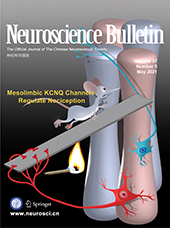Volume 37, Issue 5, 2021
 [Cover]
[Cover] The mesolimbic reward system regulates nociception. In this issue, by combining circuit-specific electrophysiological recording with chemogenetic modulation, Wang et al. demonstrate distinct changes in the firing activity of two VTA dopaminergic subpopulations during chronic pain, resulting from the alteration of KCNQ channel-mediated M-currents. Furthermore, reversal of the altered activity and M-currents in the VTA-to-NAc projection, but not in the VTA-to-mPFC dopaminergic neurons, relieves thermal hyperalgesia. The mouse in the cover image, suffering from thermal pain, is trying to escape from the fire beneath the platform. The decreased function of KCNQ channels in the VTA-to-NAc circuit (red) contributes to the behavioral response to nociception in mice. See pages 597–610. (Cover image provided by Su-Wan Hu and Jun-Li Cao).